Pneumatic System 1 : Pengertian Pneumatik
Summary
TLDRIn this video, Yudist introduces the pneumatic system and its key components, focusing on the Pneumatic Laboratory at the National Institute of Technology in Yogyakarta. The video explains the role of a compressor, regulator, and cylinders in the pneumatic system, demonstrating how air pressure is used to create movement. The types of pneumatic cylinders, including single-acting and double-acting, are covered, along with their applications in industries like material handling and air brakes. Viewers will gain insight into how pneumatic systems are assembled and controlled, with more detailed topics to be explored in future videos.
Takeaways
- 😀 Pneumatic systems use compressed air as a power source to drive mechanical components in various industries.
- 😀 The first key component in a pneumatic system is the **compressor**, which draws in air and compresses it into pressurized air.
- 😀 A **regulator** is used to control and stabilize the air pressure, ensuring it remains consistent throughout the system.
- 😀 Compressed air is delivered to different components, like **pneumatic cylinders**, through airlines or hoses.
- 😀 Pneumatic cylinders convert the energy from compressed air into linear motion, either extending or retracting.
- 😀 In pneumatic systems, forward motion of a cylinder is called **Go Plus**, while backward motion is referred to as **Tumit**.
- 😀 There are two types of pneumatic cylinders: **single-acting** and **double-acting**.
- 😀 A **single-acting cylinder** has one air inlet and relies on a spring to return the piston once the air is released.
- 😀 A **double-acting cylinder** has two air inlets, allowing more control and flexibility for both forward and backward movement.
- 😀 Pneumatic systems are commonly used for applications such as pushing, lifting, and operating systems like air brakes.
- 😀 Future videos will delve deeper into more complex pneumatic systems and provide explanations on advanced applications and troubleshooting.
Q & A
What is the main purpose of the pneumatic laboratory at the National Institute of Technology, Yogyakarta?
-The pneumatic laboratory at ITNY is used by students from the Mechanical Engineering and Electronics Engineering programs to study and understand pneumatic systems, which are widely used in industrial applications as a means of actuation.
What is a pneumatic system and how does it work?
-A pneumatic system is a mechanism that uses compressed air to create motion. The system works by drawing in air, compressing it, and using it to drive mechanical components like pistons or cylinders to perform various tasks.
What role does a compressor play in a pneumatic system?
-The compressor in a pneumatic system draws air from the environment and compresses it, creating pressurized air. This compressed air is then distributed through the system to power various components like pneumatic cylinders.
How does a regulator function within a pneumatic system?
-The regulator controls the pressure of the compressed air to ensure it remains stable throughout the system. It prevents the air pressure from becoming too high or too low, which could cause malfunction or inefficiency.
What is the function of a pneumatic cylinder in the system?
-A pneumatic cylinder acts as an actuator, converting the pressurized air into mechanical movement. It drives a piston or slider forward or backward depending on the air pressure applied.
What is the difference between 'Go Plus' and 'Go Min' in pneumatic systems?
-'Go Plus' refers to the movement when the piston is driven forward by the pressurized air, while 'Go Min' refers to the movement when the piston moves backward after the air pressure is redirected or removed.
What are the two types of pneumatic cylinders mentioned in the video?
-The two types of pneumatic cylinders mentioned are the single-acting cylinder and the double-acting cylinder. The single-acting cylinder has one input port, while the double-acting cylinder has two input ports for more complex movements.
How does a single-acting cylinder operate?
-A single-acting cylinder operates with one input port. When air is supplied to this port, the piston moves in one direction. A spring inside the cylinder helps the piston return to its original position when the air pressure is removed.
How does a double-acting cylinder differ from a single-acting cylinder?
-A double-acting cylinder has two input ports, allowing it to move the piston in both directions using compressed air. Unlike a single-acting cylinder, which only moves in one direction and relies on a spring for return, a double-acting cylinder can be controlled more precisely.
What is the importance of proper hose connections in a pneumatic system?
-Proper hose connections are crucial in a pneumatic system because they ensure that the compressed air is directed to the right components, allowing the pneumatic cylinders to move as needed for tasks such as pushing, lifting, or performing other mechanical actions.
Outlines

Cette section est réservée aux utilisateurs payants. Améliorez votre compte pour accéder à cette section.
Améliorer maintenantMindmap

Cette section est réservée aux utilisateurs payants. Améliorez votre compte pour accéder à cette section.
Améliorer maintenantKeywords

Cette section est réservée aux utilisateurs payants. Améliorez votre compte pour accéder à cette section.
Améliorer maintenantHighlights

Cette section est réservée aux utilisateurs payants. Améliorez votre compte pour accéder à cette section.
Améliorer maintenantTranscripts

Cette section est réservée aux utilisateurs payants. Améliorez votre compte pour accéder à cette section.
Améliorer maintenantVoir Plus de Vidéos Connexes

BAGIAN-BAGIAN SYSTEM PNEUMATIC

Mengenal Simbol Pneumatik dan Benda Aslinya #waginothok

Basics of Pneumatics and Pneumatic Systems: Part 1 (Animation / Sub)

Tutorial Elektopneumatik : pengenalan komponen dan cara instalasi sistem elektro-pneumatik

Sistem Hidrolik dan Pnuematik Kelompok 5

4. BELAJAR ELEKTROPNEUMATIK - MACAM MACAM SAKLAR ELEKTROPNEUMATIK
5.0 / 5 (0 votes)
